November
6, 2005
Why
the far north?
A few years ago, we took advantage of
a super airline special and flew to Anchorage for several days in November.
Among the many brochures we collected with the intent of planning some subsequent
Alaska trips was one offering day and overnight excursions to Nome. While
we probably could not have pinpointed Nome's location on map, we knew it was
"way up north." The idea of visiting Nome or one of the other remote
tundra villages greatly appealed to us. Because these outposts are so distant
from the continental US, airfare is very costly, averaging about $1050 RT
from San Diego (though $550 fares are sometimes available). At some later
point we discovered we could use our American frequent flyer miles to book
a free trip on Alaska Airlines. Frequent flyer travelers get a real bargain
on these routes since tickets require only the standard 25000 miles for domestic
trips.
Getting
there
With our frequent flyer option in hand we investigated possible destinations.
There are 3 far north villages with airports: Nome, Kotzebue, and Barrow.
We chose Barrow as it seemed the most remote. In fact it is less than 10 miles
from Point Barrow, the northernmost point in North America. That sounded downright
exotic -- if that term is applicable to a village set on permafrost.
Our next task was to secure those hard-to-get frequent flyer seats. Some test calls indicated that randomly chosen dates six months or more in advance showed no availability. So we did what all fanatic frequent flyers do. We identified our preferred dates and called for reservations 331 days in advance -- the first day tickets become available. This strategy was successful -- we got our tickets.
Questioning
our sanity
As our departure date drew closer, from time to time we, and others, questioned
our sanity or at least our judgment. Reaching Barrow was going to require
4 separate flights from San Diego: first to Seattle, then Anchorage, Fairbanks,
and finally Barrow. Weather conditions prevent flights from Fairbanks to Barrow
frequently enough that Alaska Airlines makes it explicit that they are not
responsible for lodging and other costs resulting from delayed or cancelled
flights.
A
couple of months before our departure, we found a very informative traveler's
report on the internet by a 2001 Barrow visitor. He had arrived in early February
in 2001 when the temperature was -34° with a 20-knot wind. And there is
no jet way at the airport. Passengers must descend the plane on stairs and
walk across the tarmac to the terminal. He noted that during his 4-day stay
he never did see the sky because of continual blowing snow and near zero visibility.
It all sounded a bit scary and did not do much to boost our confidence in
our judgment. You can read about his trip at: http://www.lowell.edu/users/jch/barrow/barrow.html.
Making arrangements
Our attempts to arrange some tours in Barrow were also a bit unnerving. We
had long before found several websites describing interesting sounding well
organized day tours of the vicinity and nighttime aurora tours. However, none
of the email addresses worked nor were we able to contact anyone by calling
the numbers listed on the web sites. Some numbers did not work and some reached
messages promising to call back. But no one did. With persistence, Judi finally
reached two different local guides. One said to call him when we arrived and
if the weather conditions were satisfactory he could arrange something for
us. That didn't sound too good. We were flying 6500 miles round trip to maybe
have a look around? The other guide, Buna, said his vehicle was not working
but should be repaired by the time of our visit. He suggested we call him
a few days before our arrival. Judi did so and he reported that his vehicle
was running again. He was getting married the day we would be there but not
until evening so it would be OK. Hmmm…
Regaining
our sense of adventure
As we read more about Barrow, we became increasingly enthusiastic. Barrow
is considered one of the best places in the northern hemisphere to see the
northern lights. The prime season is November through March. It was on that
basis that we had chosen October 30 as our departure date -- late enough in
the year for good aurora viewing but early enough to avoid absurdly low temperatures.
Barrow is also a summer breeding grounds for the snowy owl so there was a
chance of seeing one of these magnificent creatures. We might see an arctic
fox or perhaps caribou. With really good luck we might even see a polar bear.
We knew that daylight hours would be limited (there is 24 hour darkness from
November 18 to January 24) but the twilight conditions we would encounter
also sounded interesting. No matter what, it would be an adventure and would
satisfy our curiosity, which by this point was intense. We did notice that
not a single one of our friends expressed the slightest interest in accompanying
us.
Securing
lodging
There are three lodging options. The Top of the World has the most appealing
name but guide books made it clear that the King Eider is the best choice.
Some rooms were available with kitchenettes and that seemed like a very good
idea given the weather and the limited dining options. So we grabbed one,
a smart move as it turned out. The clever King Eider Inn web site is worth
a look. http://www.kingeider.net
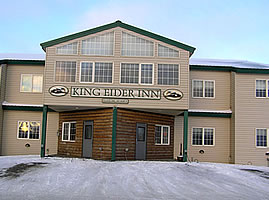
King
Eider Inn
SUNDAY, OCTOBER 30
Arriving
Anchorage
We departed San Diego at 6:30 am and changed planes in Seattle after a flight
of 1051 miles. Though Anchorage is in southern Alaska, it is still a long
way from Seattle -- 1444 miles. The city has a spectacular mountain backdrop.
As we descend, we can see that the city is blanketed by a light covering of
snow.
Anchorage International Airport
The airport has an attractive native crafts exhibit area and a stuffed polar bear so big (about 12 feet tall when on it's haunches) it is hard to believe it is real.
Arriving
Fairbanks
An easy flight of 260 miles. All of the rivers and lakes are frozen and the
pine trees glisten with a light coating of ice. The Fairbanks airport is smaller
than Anchorage's but equally new, modern and spacious.
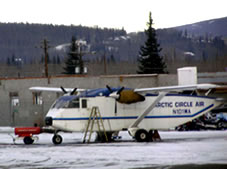
Fairbanks
Airport
Fairbanks
to Barrow
This will be another short flight of 502 miles. We notice that most of the
passengers on this flight appear to have native origins. Some speak in the
Inupiat language. As we gained altitude departing Fairbanks we were treated
to an eerie but spectacular view of the setting sun as it descended into the
clouds.

A pale orange and pink sunset illuminated the horizon for the entire duration of our flight to Barrow.
Arriving
Barrow
Barrow lies 340 miles north of the Arctic Circle, 1300 miles south of the
North Pole. As we approach Barrow hurtling into the darkness, with blowing
snow visible in the wing lights, we are reminded of one of those airplane
disaster films. We are finally going to learn what we have gotten ourselves
into this time. The forecast high in San Diego was 78° for today, 86°
tomorrow. Barrow? About 6° for the high each day. We reach for our parkas.
The cold seems tolerable as we descend the stairs and make our way across
the tarmac to the terminal.
The modern one room Barrow airport is a prefabricated metal building assembled in 1998. We peer out into the light snow and spot the King Eider Inn directly across the street, about a 30 second walk. The hotel, named after the King Eider duck, and also built in 1998 is a delight -- warm, comfy, friendly and cheery.
MONDAY, OCTOBER 31
Seeing
Barrow
Barrow has a population of about 4500. It is the administrative center of
the borough (like a county), a vast region the size of Minnesota. There are
7 other tiny villages in the borough the largest of which has 300 hardy residents.
There is no downtown per se, only a few scattered cafes, a bank, a general
store and a museum. The town and indeed the whole region sets on permafrost
beginning a foot or so below ground level. The homes are small and many belongings
are left outside. Curing racks for skins are placed adjacent to most homes
along with boats and other equipment. Food is stored outside from October
through April, no refrigerator needed.
Most of the residents are Inupiat natives. It is common for natives to ask a visitor where they are from "on the outside" as if they come from a different planet.
Polar bears seldom enter the village (they are not allowed) but several residents told us about occasional sightings in the town. The new managers of the King Eider (who moved to Barrow 2 months ago from Tallahassee Florida!) were cautioned not to walk the several blocks from the hotel to the gym in the early morning darkness because of the potential bear danger.
Most of the food consumed by the residents is obtained by hunting and fishing. Natives are allowed to take a limited number of whales, seals, and walruses and an unlimited amount of salmon and other fish. Caribou is another important staple. Natives are also allowed to hunt polar bears. About 4 are taken per year. Greens and berries can sometimes be gathered in the summer months. Gardening is not possible. A native told us that storms bring in sea life such as shrimp and even octopus and they too can be added to the diet.
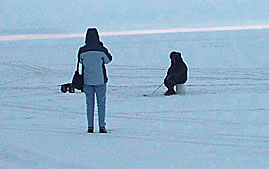
Judi
Photographs Inupiat Fisherman
There is no industry in Barrow except for a very modest amount of tourism. The largest employer is the school system followed by various government agencies. Schools are quite modern and well equipped, thanks to oil royalties from the North Slope that generate about 100 million dollars per year for the borough. The new high school was built at a cost of 174 million dollars. Civil service salaries are high.
Touring
the Barrow area
It was still 6° below zero when our guide Buna arrived on schedule just
after daylight at 10 am to meet us and two other King Eider guests, both veteran
Alaska travelers. The temperature would eventually rise all the way to 10°
above zero. That's balmy compared to the conditions that will prevail in December
through March. By late December, the sun will remain below the horizon for
about two months. Buna tells us that during this period of "24 hour darkness"
there will still be decent light from about 11 am to 1 pm. Put another way,
you can experience sunrise and sunset within a 2 hour time span.
We first drove out to the Chukchi Sea toward Point Barrow. There are King Eider ducks in the water and we can see slushy ice perhaps a quarter of a mile beyond the shore. Opposite the sea, there is frozen tundra as far as the eye can see. The landscape is completely devoid of vegetation except for some brown blades of grass visible underneath the current light coating of surface snow and ice. A deep layer of permafrost begins about a foot below the surface, extending to 15,500 feet below the surface, i.e., about 3 miles deep! A pale pink line burnishes the horizon above the tundra, reminding us (as if we needed it) that we are in a unique environment.
We
had hoped to make it all the way to the point because polar bears can often
be seen there but the ice was still too slushy for driving. A 2002 tally recorded
89 polar bears in the Point Barrow region. There are believed to be about
30,000 across the entire Arctic expanse. A herd of about 23,000 Arctic caribou
also visits the Barrow area each year in the early spring.
We encountered a lone ice fisherman about 75 yards away from our stopping
point. He had his rifle handy in case a polar bear happened by. These are
the only bears that seek out humans as food. Yikes! Buna says it will be OK
to walk over toward him but to watch out for polar bears. He didn't say what
to do should we see one.
Nearby stands the work of a local humorist -- a grove of palms with whale baleen serving as fronds and trunks constructed of driftwood. These are the only trees in Barrow.
We are only out of the van for about 5 minutes when our faces (our only exposed surface) begin to hurt. Our fingers sting when we remove our gloves to take pictures.
As we resume our drive we pass by what remains of the once extensive Distant Early Warning installation, the US government's famous DEW line, designed to detect bomber or missile incursions from the Soviet Union during the cold war was of the 1950's and 1960's. A few minutes later we spot a beautiful Arctic fox and then a group of pure white ptarmigans.
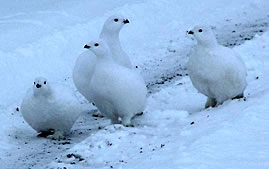
Ptarmigans
We head down a different road in search of snowy owls and caribou. Lemmings (small rodents) are present in this vicinity and they attract the owls. At 12:30, a rather bright sun appears -- for about 10 minutes -- and that was it for the day. Minutes later, light snow begins to fall. Then we get lucky, spotting a beautiful young female snowy owl perched on an electrical pole.
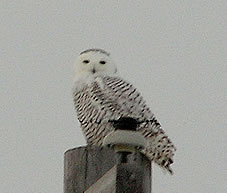
Snowy
Owl
Having met just about all our objectives except seeing a polar bear, we returned for a spin around the town. Buna had invited us to his home to try whale meat stew but alas his mother was not home.
In contrast to most places, the cheapest properties are near the beaches as they are being threatened by eroding shorelines, possibly due to global warming. Oddly, you pay higher taxes if you paint your house as you will have increased its value.
At the end of our 3 and a quarter hour tour, Buna dropped us and our two fellow travelers off at the Inupiat Heritage Museum. After a look around the modern museum, we walked across the street to the large general store. It apparently is the only retail outlet in town for groceries and other merchandise (such as clothes, toys, and drug store items). Prices are two to three times higher than in the lower 48 as everything has to be shipped in by air freight.
For dinner, we had a prepackaged chicken and dumplings meal we had brought with us, saving ourselves a trip out in the evening cold, a $12 to $14 round trip taxi ride to a café and a dinner tab of $40 or more.
For the second night in a row, we set our alarms for midnight and then again for 1 am and 2 am in case auroral activity was visible. But, alas, it was cloudy, precluding any possible viewing opportunity.
TUESDAY, NOVEMBER 1
It was still 6° below zero this morning. We had breakfast in our room, checked out, and walked to the airport -- in the dark at 9:15 am. Our flight departed on schedule at 10 am. Right before takeoff the crew alerted passengers to an Arctic fox just beyond the runway. We are treated to another beautiful pale sunrise as we gain altitude and then great views of the spectacular Brooks Range, deeply covered in snow.
It is 6 below zero when we arrive in Fairbanks but the sun is out. As we were leaving the airport grounds in our rented car, we see a red fox. We spend the day exploring Fairbanks, visiting the excellent Museum of the North on the University of Alaska Fairbanks campus, and collecting information on things to see and do in Alaska. Our B&B has several aurora viewing areas and though it is a clear night, our numerous checks for auroral displays between 11 pm and 2 am go unrewarded and then clouds move in.
We depart for home in the morning impressed by the diversity of Alaska's natural resources, its friendliness and its overwhelming physical beauty. En route to Anchorage, we catch sight of the incredibly spectacular mountains at Denali National Park. We resolve to return to see Denali and some of the many other natural wonders of Alaska.

